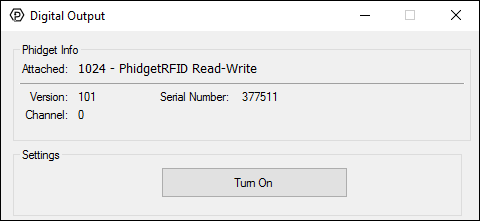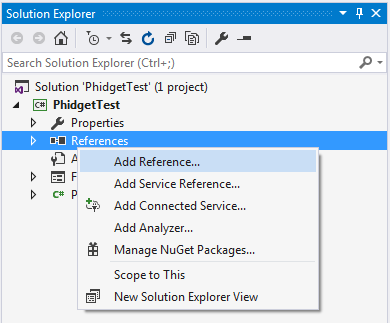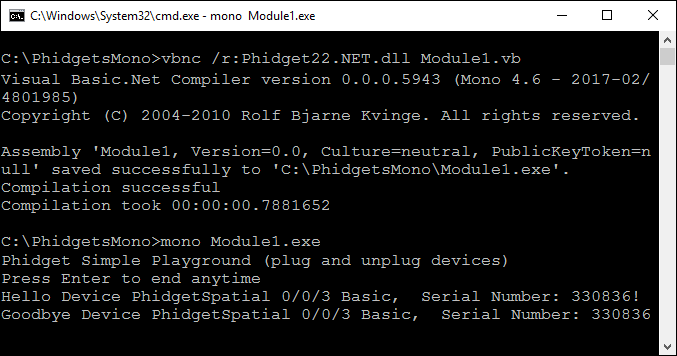Language - Visual Basic .NET: Difference between revisions
No edit summary |
No edit summary |
||
| Line 1: | Line 1: | ||
[[Category:Language]] | [[Category:Language]] | ||
__TOC__ | __TOC__ | ||
== Quick Downloads == | == Quick Downloads == | ||
| Line 25: | Line 19: | ||
== Getting Started with VB.NET == | == Getting Started with VB.NET == | ||
Welcome to using Phidgets with VB.NET! By using VB.NET, you will have access to the complete {{Phidget22API}}, including events. We also provide example code in VB.NET for all Phidget devices. | |||
{{ | |||
== Windows == | == Windows == | ||
{{Windows_Languages}} | |||
===Visual Studio | ===Visual Studio=== | ||
====Use our examples==== | |||
One of the best ways to start programming with Phidgets is to use our example code as a guide. In order to run the examples, you will need to download and install [https://www.visualstudio.com/ Microsoft Visual Studio]. | |||
Now that you have Microsoft Visual Studio installed, select an example that will work with your Phidget: | |||
*{{SampleCode|VBNET|VB.NET Examples}} | |||
Open the example project and start the example by pressing the ''Start'' button: | |||
[[File:Csharp_visualstudio_run.png |link=|center]] | |||
The application will open the Phidget, list basic information about the Phidget, and demonstrate the Phidget's functionality. Here is an example of a Digital Output channel on a RFID Phidget: | |||
= | [[File:Csharp_visualstudio_rfid.PNG|link=|center]] | ||
You should now have the example up and running for your device. Play around with the device and experiment with some of the functionality. When you are ready, the next step is configuring your project and writing your own code! | |||
====Configure your project==== | |||
When you are building a project from scratch, or adding Phidget functionality to an existing project, you'll need to configure your development environment to properly link the Phidget .NET library. To begin: | |||
Create a new Windows Forms Application project: | |||
[[Image: | [[Image:Vbnet_newproject.PNG|link=|center]] | ||
Next, right-click to add a reference to the Phidget .NET library: | |||
[[Image:CSharp_VS2015_Add_Reference.png|link=|center]] | |||
On the following screen, click ''Browse...'' and navigate to the location of Phidget22.NET.dll: | |||
*C:\Program Files\Phidgets\Phidget22\Phidget22.NET.dll | |||
[[Image:CSharp_VS2015_Add_Reference_2.png|link=|center]] | |||
Finally, to include the Phidget .NET library, add the following lines to main window class file: | |||
<syntaxhighlight lang= | <syntaxhighlight lang="csharp"> | ||
Imports Phidget22 | |||
Imports Phidget22.Events | |||
</syntaxhighlight> | </syntaxhighlight> | ||
Success! The project now has access to Phidgets. Next, view the [[#Write Code | write your own code]] section located below. | |||
===Mono=== | |||
====Use Our Examples==== | ====Use Our Examples==== | ||
One of the best ways to start programming with Phidgets is to use our example code as a guide. In order to run the examples, you will need to download and install [http://www.mono-project.com/download/ Mono] for Windows. | |||
Now that you have Mono installed, download and unpack the HelloWorld example for C#: | |||
*[{{SERVER}}/downloads/phidget22/examples/dotnet/csharp/Manager/Phidget22_HelloWorld_CSharp_Windows_Ex.zip HelloWorld example] | |||
Note: The HelloWorld example is compatible with Mono because it does not use Windows Forms. All other C# examples use Windows Forms. | |||
Next, copy Phidget22.NET.dll from type the following location: | |||
*C:\Program Files\Phidgets\Phidget22\Phidget22.NET.dll | |||
Place both the HelloWorld example and the Phidget22.NET.dll file in the same location. Your folder should now look something like this: | |||
[[File:Vbnet_folder.PNG|link=|center]] | |||
Open the command prompt at the folder location and enter the following command: | |||
<syntaxhighlight lang='bash'> | |||
vbnc /r:Phidget22.NET.dll Module1.vb | |||
</syntaxhighlight> | |||
= | This will create an executable file called ''Module1.exe''. Type in the following command to run the example: | ||
<syntaxhighlight lang='bash'> | |||
mono Module1.exe | |||
</syntaxhighlight> | |||
[[File:Vbnet_mono.PNG|link=|center]] | |||
You should now have the example up and running. When you are ready, the next step is configuring your project and writing your own code! | |||
====Configure your project - IN PROGRESS (LUCAS)==== | |||
When you are building a project from scratch, or adding Phidget functionality to an exisiting project, you'll need to configure your development environment to properly link the Phidget .NET library. | |||
To include the Phidget .NET library, simply add the following lines to your code: | |||
<syntaxhighlight lang='CSharp'> | |||
Imports Phidget22 | |||
Imports Phidget22.Events | |||
</syntaxhighlight> | |||
The | The project now has access to Phidgets. Next, view the [[#Write Code | write your own code]] section located below. | ||
== | ==Write Code== | ||
By following the instructions for your operating system and compiler above, you probably now have a working example and want to understand it better so you can change it to do what you want. This teaching section has resources for you to learn from the examples and write your own. | By following the instructions for your operating system and compiler above, you probably now have a working example and want to understand it better so you can change it to do what you want. This teaching section has resources for you to learn from the examples and write your own. | ||
Revision as of 20:58, 6 June 2017
Quick Downloads
Documentation
- Phidget22 API (Select C#/VB.Net from drop-down menu)
Example Code
Libraries and Drivers
Getting Started with VB.NET
Welcome to using Phidgets with VB.NET! By using VB.NET, you will have access to the complete Phidget22 API, including events. We also provide example code in VB.NET for all Phidget devices.
Windows
If you haven't already, please visit the Windows page before you continue reading. There you will be instructed on how to properly set up your Windows machine so you can follow the guides below!
Visual Studio
Use our examples
One of the best ways to start programming with Phidgets is to use our example code as a guide. In order to run the examples, you will need to download and install Microsoft Visual Studio.
Now that you have Microsoft Visual Studio installed, select an example that will work with your Phidget:
Open the example project and start the example by pressing the Start button:

The application will open the Phidget, list basic information about the Phidget, and demonstrate the Phidget's functionality. Here is an example of a Digital Output channel on a RFID Phidget:

You should now have the example up and running for your device. Play around with the device and experiment with some of the functionality. When you are ready, the next step is configuring your project and writing your own code!
Configure your project
When you are building a project from scratch, or adding Phidget functionality to an existing project, you'll need to configure your development environment to properly link the Phidget .NET library. To begin:
Create a new Windows Forms Application project:

Next, right-click to add a reference to the Phidget .NET library:

On the following screen, click Browse... and navigate to the location of Phidget22.NET.dll:
- C:\Program Files\Phidgets\Phidget22\Phidget22.NET.dll

Finally, to include the Phidget .NET library, add the following lines to main window class file:
Imports Phidget22
Imports Phidget22.Events
Success! The project now has access to Phidgets. Next, view the write your own code section located below.
Mono
Use Our Examples
One of the best ways to start programming with Phidgets is to use our example code as a guide. In order to run the examples, you will need to download and install Mono for Windows.
Now that you have Mono installed, download and unpack the HelloWorld example for C#:
Note: The HelloWorld example is compatible with Mono because it does not use Windows Forms. All other C# examples use Windows Forms.
Next, copy Phidget22.NET.dll from type the following location:
- C:\Program Files\Phidgets\Phidget22\Phidget22.NET.dll
Place both the HelloWorld example and the Phidget22.NET.dll file in the same location. Your folder should now look something like this:

Open the command prompt at the folder location and enter the following command:
vbnc /r:Phidget22.NET.dll Module1.vb
This will create an executable file called Module1.exe. Type in the following command to run the example:
mono Module1.exe

You should now have the example up and running. When you are ready, the next step is configuring your project and writing your own code!
Configure your project - IN PROGRESS (LUCAS)
When you are building a project from scratch, or adding Phidget functionality to an exisiting project, you'll need to configure your development environment to properly link the Phidget .NET library.
To include the Phidget .NET library, simply add the following lines to your code:
Imports Phidget22
Imports Phidget22.Events
The project now has access to Phidgets. Next, view the write your own code section located below.
Write Code
By following the instructions for your operating system and compiler above, you probably now have a working example and want to understand it better so you can change it to do what you want. This teaching section has resources for you to learn from the examples and write your own. Your main reference for writing VB.NET code will be the Phidget22 API Manual.
Code Snippets
The following code snippets describe how to do various general tasks with Phidgets. You should be able to find places in the examples where these snippets exist, and modify them to suit your requirements.
Step One: Initialize and Open
The Open() function opens the software object, but not hardware. So, it is not a guarantee you can use the Phidget immediately.
For example, if we were using an Digital Input as our device, the create and open calls would look like this:
device = New Phidget22.DigitalInput()
device.Open()
Step Two: Wait for Attachment (plugging in) of the Phidget
To use the Phidget, it must be plugged in (attached). We can handle this simply by calling open with a number as a parameter in place of the basic open. This function works for any Phidget. This will block until a connection is made to the Phidget, or the specified timeout is exceeded:
device.Open(5000);
Sometimes, it makes more sense to handle the attachment via an event. This would be in instances where the Phidget is being plugged and unplugged, and you want to handle these incidents. Or, when you want to use event-driven programming because you have a GUI-driven program. In these cases, an event-driven code snippet to handle the attachment might look something like this:
Private Sub device_Attach(ByVal sender As Object, ByVal e As Phidget22.Events.AttachEventArgs) Handles device.Attach
Dim attachedDevice As Phidget22.Phidget = CType(sender, Phidget22.Phidget)
Dim serialNumber as Integer
Dim deviceName as String
serialNumber = attachedDevice.DeviceSerialNumber;
deviceName = attachedDevice.DeviceName;
Console.WriteLine("Hello Device {0}, Serial Number: {1}!", deviceName, serialNumber.ToString());
End Sub
Step Three: Do Things with the Phidget
We recommend the use of event driven programming when working with Phidgets. This allows the program to execute other tasks until the Phidget generates a new event. You can hook a custom function into an event trigger like this, using a Digital Input Phidget as an example:
Private Sub device_DigitalInputChange(ByVal sender As Object, ByVal e As Phidget22.Events.DigitalInputStateChangeEventArgs) Handles device.StateChange
textBox1.Text = "State: " + e.State;
End Sub
Some values can be directly read and set on the Phidget. These functions can be used inside a polling loop as an alternative to event driven programming. The line inside the loop would be something like this, after which you could do something with the value:
val = device.State;
device.State = true;
Step Four: Close and Delete
At the end of your program, be sure to close your device.
Private Sub Form1_FormClosing(ByVal sender As Object, ByVal e As System.Windows.Forms.FormClosingEventArgs) Handles Me.FormClosing
device.Close();
End Sub
Further Reading
Phidget Programming Basics - Here you can find the basic concepts to help you get started with making your own programs that use Phidgets.
Data Interval/Change Trigger - Learn about these two properties that control how much data comes in from your sensors.
Using Multiple Phidgets - It can be difficult to figure out how to use more than one Phidget in your program. This page will guide you through the steps.
Polling vs. Events - Your program can gather data in either a polling-driven or event-driven manner. Learn the difference to determine which is best for your application.
Logging, Exceptions, and Errors - Learn about all the tools you can use to debug your program.
Phidget Network Server - Phidgets can be controlled and communicated with over your network- either wirelessly or over ethernet.
